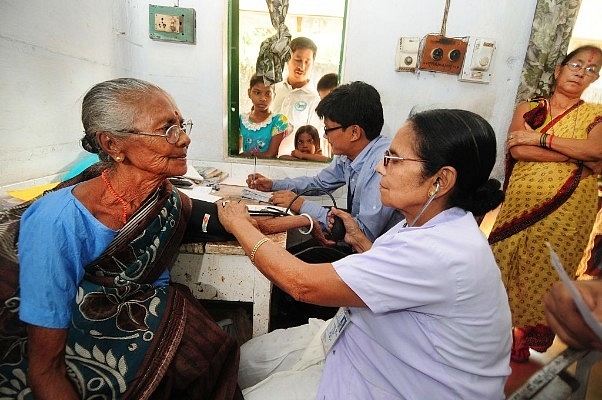Economy
Modicare: India Enters Next Generation Of Social Security With Flagship Healthcare Scheme
- Budget 2018 is path-breaking for its sheer size, coverage and amount committed per family, almost reaching out to the holy grail of universal health coverage.

A health camp (Indranil Bhoumik/Mint via Getty Images)
In an earlier article on five strategies to wake up the moribund Indian public healthcare system, the first strategy recommended by yours truly was to “declare health as a fundamental right and to provide universal healthcare”. Excerpt:
Today, the Union budget 2018-19 took a major step towards universal health coverage, although it did not declare health as a fundamental right.
The Government of India took a definite step forward towards providing universal health coverage under the National Health Protection Scheme (NHPS). As part of this, the government will provide health insurance worth Rs 5 lakh to 10 crore poor families across India, approximately covering 50 crore people out of a 130 crore population. It will be the largest government-funded health insurance scheme to be implemented anywhere in the world as per the available statistics.
Under NHPS, the poor in India will receive medical treatment in secondary and tertiary hospitals free of cost, covered by government-funded health insurance. This will come as a boon to the poor as “out of pocket payment” was the single-most common cause of a sudden emergent financial crisis among rural folk and urban poor of India. Each year, as per available data, more than 40 million people in the country, mostly rural folk and urban poor, are impoverished, get entangled in a financial crisis and bear the burden of massive debts to access secondary/tertiary/quaternary care in India. This flagship programme, although not universal, is still welcome.
In addition, the government will set up 1.5 lakh health and wellness centres or community healthcare clinics across India under the Ayushman Bharat programme. Under this plan, these 1.5 lakh health centres will be a means to “bring healthcare closer home”, provide healthcare support for non-communicable diseases, maternal and childcare services, along with free drugs and diagnosis. The government is allotting Rs 1,200 crore for this programme and said it will ask private enterprises to join the programme as part of its corporate social responsibility (CSR) initiatives.
This flagship primary care programme needs to be analysed with data available on non-communicable diseases (NCDs) to understand how important this initiative is to the country and our healthcare policy. Successive governments had been asinine in their approach using fiscal prudence, not allocating adequate funds and policy importance to NCDs.
NCDs along with accidents today account for nearly 52 per cent of deaths and effectuate a loss of 6 per cent to our gross domestic product (GDP), as economically productive citizens die prematurely. This programme is trying to address the rising burden of NCDs and will also go a long way towards reducing the burden on our tertiary centres. Since drugs are made available free of cost, it will ensure compliance of patients and disease progression, with its complications stalled. This will help improve economic productivity of individuals as well as the GDP numbers. This confirms to the second strategy recommended earlier. Excerpt:
Although the Ayushman Bharat programme does not completely address the much-required drug policy, it along with the Jan Aushadhi scheme should be able to complement the NHPS to move closer towards the sought-after goal of universal health coverage.
The Ayushman Bharat programme is also in sync with a part of the recommended fourth strategy, where primary care and prevention is accorded more importance than, say, for tertiary care with curative bias. Excerpt:
Allotting Rs 600 crore at the rate of Rs 500 for every tuberculosis patient every month, to provide nutritional support, displays the sincere thought process of the government in trying to reduce the disease burden on its citizens. Tuberculosis is a notoriously difficult disease to cure and especially so when the patient’s nutritional status is bad.
The government has committed itself to opening 24 new medical colleges, including upgrading a few existing colleges and ensuring that there is at least one government medical college in every state. This again confirms to recommendations from another article of mine about medical education and regulation of practice.
Overall, the budget 2018 is path-breaking for its sheer size, coverage and amount committed per family, almost reaching out to the holy grail of universal health coverage. This along with other measures (like guaranteed minimum income to be rolled out by some states) will take India into the next generation of social security, as the country moves rapidly from a progressive developing economy to a developed one.
Support Swarajya's 50 Ground Reports Project & Sponsor A Story
Every general election Swarajya does a 50 ground reports project.
Aimed only at serious readers and those who appreciate the nuances of political undercurrents, the project provides a sense of India's electoral landscape. As you know, these reports are produced after considerable investment of travel, time and effort on the ground.
This time too we've kicked off the project in style and have covered over 30 constituencies already. If you're someone who appreciates such work and have enjoyed our coverage please consider sponsoring a ground report for just Rs 2999 to Rs 19,999 - it goes a long way in helping us produce more quality reportage.
You can also back this project by becoming a subscriber for as little as Rs 999 - so do click on this links and choose a plan that suits you and back us.
Click below to contribute.
Latest